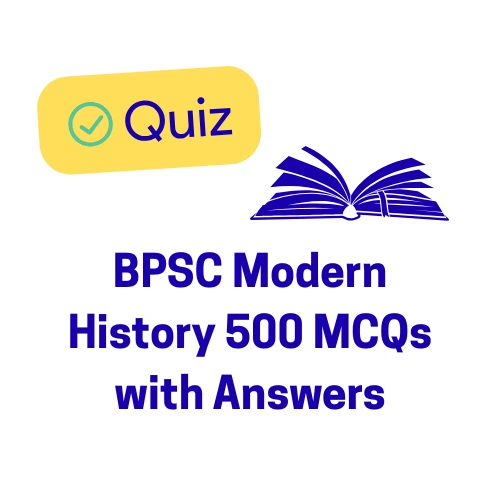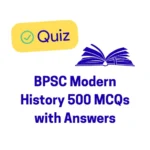BPSC Modern History Part 10 (500 MCQs) focus on the Montagu-Chelmsford Reforms (1919), the Rowlatt Satyagraha, Jallianwala Bagh Massacre, Khilafat Movement, and the Non-Cooperation Movement (1919-1922).
BPSC Modern History Part 10 (500 MCQs)
Section X: Montagu-Chelmsford Reforms and Rowlatt Satyagraha
Q271. The Government of India Act, 1919 is also famously known as the:
(A) Minto-Morley Reforms
(B) Montagu-Chelmsford Reforms
(C) August Offer
(D) Cripps Proposal
Q272. Which of the following constitutional provisions was introduced at the provincial level by the Government of India Act, 1919?
(A) Provincial Autonomy
(B) Diarchy (or Dyarchy)
(C) Complete Independence
(D) Separate electorates for all minorities
Q273. Under the Diarchy system at the provincial level, which of the following subjects was classified as ‘Transferred’?
(A) Finance
(B) Law and Order
(C) Education
(D) Revenue
Q274. The Act of 1919 provided for the creation of a bicameral legislature at the Centre. These two houses were the:
(A) Legislative Assembly and Council of States
(B) House of Commons and House of Lords
(C) Central Legislative Council and Imperial Legislative Council
(D) Lok Sabha and Rajya Sabha
Q275. The Montagu-Chelmsford Reforms were opposed by the INC because:
(A) The introduction of Diarchy was criticized as an irresponsible government.
(B) The Governor-General’s power remained supreme.
(C) Only a small section of the Indian population got the right to vote.
(D) All of the above
BPSC Modern History Part 10 (500 MCQs)
Q276. The Rowlatt Act (1919) was based on the recommendations of which committee?
(A) Sadler Commission
(B) Hunter Committee
(C) Rowlatt Committee
(D) Peel Commission
Q277. What was the main provision of the Rowlatt Act, which led Mahatma Gandhi to call it the ‘Black Act’?
(A) It drastically reduced the age limit for the Civil Services Examination.
(B) It allowed the government to imprison any person without trial and without judicial review (Habeas Corpus).
(C) It legalized the forced cultivation of Indigo.
(D) It introduced separate electorates for Sikhs.
Q278. The first countrywide mass agitation organized by Mahatma Gandhi against the British was the:
(A) Champaran Satyagraha
(B) Khilafat Movement
(C) Rowlatt Satyagraha
(D) Non-Cooperation Movement
Q279. In Punjab, which two prominent leaders were arrested under the Rowlatt Act, leading to widespread protests that culminated in the Jallianwala Bagh Massacre?
(A) Lala Lajpat Rai and Bipin Chandra Pal
(B) Dr. Saifuddin Kitchlew and Dr. Satyapal
(C) Sardar Vallabhbhai Patel and Indulal Yagnik
(D) Bhagat Singh and Sukhdev
Q280. Which famous Indian personality renounced his knighthood (title) in protest against the Jallianwala Bagh Massacre?
(A) Mahatma Gandhi
(B) Jawaharlal Nehru
(C) Rabindranath Tagore
(D) Surendranath Banerjee
Section Y: Jallianwala Bagh and Khilafat Movement
Q281. The Jallianwala Bagh Massacre took place on which date?
(A) April 6, 1919
(B) April 13, 1919 (Baisakhi Day)
(C) March 10, 1919
(D) May 1, 1919
Q282. The British military commander who ordered the troops to open fire on the unarmed crowd at Jallianwala Bagh was:
(A) General Dyer (Reginald Edward Harry Dyer)
(B) Sir Michael O’Dwyer (Lieutenant Governor of Punjab)
(C) Lord Chelmsford (Viceroy)
(D) General Ochterlony
Q283. Who was the former Lieutenant Governor of Punjab, Sir Michael O’Dwyer, who was assassinated in London in 1940 as an act of revenge for the Jallianwala Bagh massacre?
(A) Bhagat Singh
(B) Udham Singh
(C) Rajguru
(D) Chandrashekhar Azad
Q284. The British Government appointed which committee to inquire into the Jallianwala Bagh Massacre?
(A) Sadler Commission
(B) Montagu Committee
(C) Hunter Committee
(D) Muddiman Committee
Q285. The Khilafat Movement was launched by Indian Muslims to protest against the injustice done to which figure/entity after World War I?
(A) The Sultan of Turkey (Caliph or Khalifa)
(B) The King of Saudi Arabia
(C) The Shah of Persia
(D) The Mughal Emperor
BPSC Modern History Part 10 (500 MCQs)
Q286. Who were the main leaders of the Khilafat Movement in India?
(A) Maulana Abul Kalam Azad and Dr. Zakir Hussain
(B) Muhammad Ali Jinnah and Liaquat Ali Khan
(C) Ali Brothers (Maulana Muhammad Ali and Shaukat Ali)
(D) Sir Syed Ahmad Khan and Nawab Salimullah
Q287. Mahatma Gandhi viewed the Khilafat Movement as:
(A) A purely religious matter in which the INC should not interfere.
(B) An opportunity to unite Hindus and Muslims in the national struggle.
(C) A terrorist movement that should be condemned.
(D) A secondary issue compared to the Rowlatt Satyagraha.
Q288. The All India Khilafat Committee was formed in which year?
(A) 1916
(B) 1919
(C) 1920
(D) 1922
Q289. Which Indian leader was strongly opposed to the Congress alliance with the Khilafat Movement, viewing it as a communal issue?
(A) M. A. Jinnah
(B) Abul Kalam Azad
(C) C. R. Das
(D) Motilal Nehru
Q290. The Khilafat issue ceased to be a political factor after which event?
(A) The Chauri Chaura incident.
(B) The merger of the Khilafat Committee with the INC.
(C) The abolition of the Caliphate by Mustafa Kemal Pasha in Turkey in 1924.
(D) The arrest of the Ali Brothers.
Section Z: Non-Cooperation Movement (1920-1922)
Q291. The Non-Cooperation Movement was formally launched in 1920 after which session of the INC?
(A) Calcutta Session (Special, September 1920)
(B) Nagpur Session (Regular, December 1920)
(C) Madras Session, 1927
(D) Lahore Session, 1929
(E) More than one of the above
Q292. The main goal/goals of the Non-Cooperation Movement was/were:
Rectification of the Punjab Wrong (Jallianwala Bagh).
Rectification of the Khilafat Wrong.
Attainment of Swaraj.
(A) 1 and 2 only
(B) 2 and 3 only
(C) 1 and 3 only
(D) 1, 2, and 3
Q293. The program of the Non-Cooperation Movement included which of the following?
(A) Boycott of government schools, colleges, and law courts.
(B) Surrender of titles and honorary offices.
(C) Boycott of foreign goods.
(D) All of the above
Q294. Who was the leader who strongly opposed the Non-Cooperation resolution in the beginning but later actively participated in the movement?
(A) Jawaharlal Nehru
(B) Sardar Vallabhbhai Patel
(C) C. R. Das
(D) Rajendra Prasad
Q295. The Non-Cooperation Movement saw the establishment of several national educational institutions. Which of the following was/were established during this period?
(A) Jamia Millia Islamia
(B) Kashi Vidyapith
(C) Gujarat Vidyapith
(D) All of the above
BPSC Modern History Part 10 (500 MCQs)
Q296. The Non-Cooperation Movement was abruptly suspended by Mahatma Gandhi due to which incident?
(A) Jallianwala Bagh Massacre
(B) Chauri Chaura Incident
(C) Arrest of Ali Brothers
(D) The abolition of the Caliphate
Q297. The Chauri Chaura Incident, where a crowd of peasants set fire to a police station killing 22 policemen, took place in which present-day state?
(A) Bihar
(B) West Bengal
(C) Uttar Pradesh (Gorakhpur district)
(D) Punjab
Q298. Who was the only major leader to support Gandhi’s decision to immediately suspend the Non-Cooperation Movement after Chauri Chaura?
(A) Motilal Nehru
(B) Jawaharlal Nehru
(C) C. R. Das
(D) Sardar Vallabhbhai Patel
Q299. After the withdrawal of the Non-Cooperation Movement, Mahatma Gandhi was arrested and sentenced to six years’ imprisonment for his articles in which newspaper?
(A) Young India
(B) Harijan
(C) Navajivan
(D) More than one of the above
Q300. The INC session of 1922, which saw the formation of the Swaraj Party by those who opposed the sudden suspension of the Non-Cooperation Movement, was held in:
(A) Gaya (Bihar)
(B) Calcutta
(C) Nagpur
(D) Lucknow

